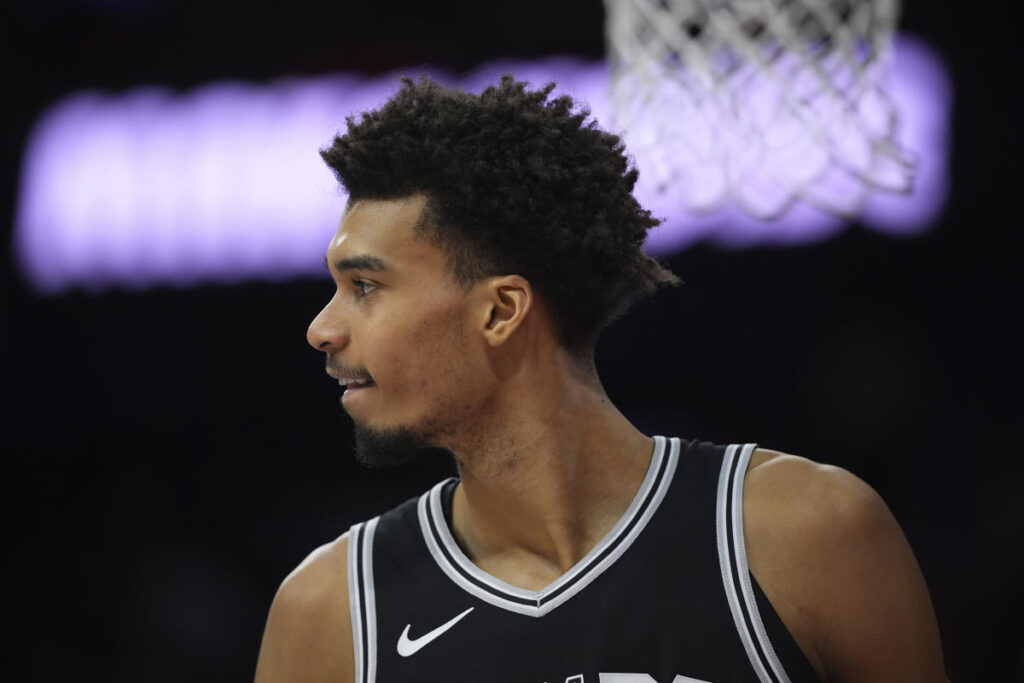Victor Wembanyama’s remarkable start to his career will be put on hold due to a blood clot. On Thursday, the Spurs announced the 7-foot-5 phenom had suffered a deep vein thrombosis — a blood clot — in his right shoulder and will be shut down for the remainder of the 2024-25 season.
It’s a scary diagnosis for the 21-year-old and a devastating development for the Spurs, who just acquired one-time All-Star guard De’Aaron Fox at the trade deadline for a playoff push. Wembanyama, who made his first All-Star appearance over the weekend in San Francisco, solidified himself as one of the league’s top players this season and ranked as the odds-on favorite to win Defensive Player of the Year, leading the league in blocks by an astounding 74 rejections.
But more subtly, Wembanyama also led the league in a different category this season that felt ominous on Thursday: most miles traveled.
The San Antonio Spurs criss-crossed the globe this season, flying thousands of miles from Portland to Paris and seemingly everywhere in between. Add up all the travel and you’ll find the Spurs traveled 37,852 miles by the All-Star break, according to Positive Residual schedule analysis. That ranks as the most for any team in the NBA and nearly 80 percent higher than teams like the Charlotte Hornets and Detroit Pistons.
It’s a fact that was initially alarming to this writer, who covered Chris Bosh in Miami and chronicled the unfortunate story of blood clots that forced him to end his career in the middle of his prime at age 31. The timing of the Wembanyama news and Bosh’s was also eerily similar. Both of Bosh’s blood clot occurrences came around the All-Star break in February of 2015 and 2016.
At the time, Bosh told me that extensive travel within the NBA schedule contributed to his blood clots in his legs that had reached his lungs. Long sedentary rests on flights aren’t ideal for 7-footers who need to pump blood throughout their limbs.
“You sit so much,” Bosh said, slouching in his locker chair. “You’re like this for two hours. If you get kicked, blood just pools up somewhere and you don’t move it, it just sits there.”
Bosh, who stands 6-foot-11, was an All-Star in his final season of 2015-16.
“We got strong hearts,” Bosh said, pointing down to his feet, “but that’s a long way away.”
It’s even longer for Wembanyama, who is the tallest player in the NBA armed with a wingspan stretching eight feet wide.
But there’s a key difference between Bosh’s career-ending blood clots and Wembanyama’s season-ending blood clot. Bosh’s blood clots were not found to be in his shoulders like Wembanyama. And that might be a silver lining for Wembanyama.
I asked Dr. Brian Sutterer, one of the most well-known sports injury doctors, if Wembanyama’s frequent flying may have been a risk factor for his newly discovered condition.
Sutterer didn’t see it that way.
“I don’t think travel played a role,” Sutterer told me. “The most common location for a deep vein thrombosis is the legs, and it’s often related to the blood pooling from long-term immobilization like air travel or recovery from surgery. If Wembanyama’s was a clot in the leg, absolutely the long travel could be a factor. But in the arm, his anatomy and repetitive motion is the likely cause.”
Sutterer indicated that overhead motions — like, say, shooting a basketball — can create what’s called thoracic outlet syndrome, which occurs due to repetitive compression and stress on the vein below the clavicle. It’s not a surprise, Sutterer noted, that Wembanyama’s blood clot was found inside the arm that he shoots with, his right shoulder.
On Thursday night, Spurs interim head coach Mitch Johnson shed more light on Wembanyama’s status going forward, saying the Spurs expect Wembanyama to be ready for next season.
“His arm didn’t feel completely normal,” Johnson told the media. “This started by conversations around Monday. I don’t know exactly the time. It was our medical staff. They looked into it, and that’s how we got here.”
Sutterer commends Wembanyama and the Spurs’ medical team for detecting it before it endangered his life.
“What’s terrifying about this is that the clot was likely there during the All-Star Game and could have moved to the lung and killed him,” Sutterer said. “I’m really impressed the Spurs doctors found it in just 24-48 hours.”
If it’s not Bosh, the closest reference point for Wembanyama’s case is another slender star, Brandon Ingram. The Toronto Raptor underwent thoracic outlet decompression surgery on his shooting arm in March 2019 when doctors found a blood clot in his shoulder as a 21-year-old with the Los Angeles Lakers.
“I was feeling this little pinch in my armpit,” Ingram said at the time, “and I was just trying to figure out what was wrong.”
Doctors removed a portion of his rib that compressed his vein and he was put on blood thinners to ease blood flow. After that operation, Ingram was traded to the Pelicans in the Anthony Davis deal and Ingram returned the next season with a vengeance, making his first All-Star appearance and winning Most Improved Player.
Ingram represents something of a best-case scenario for Wembanyama, as Ingram has averaged 23 points, 5.5 rebounds and 5.2 assists since his diagnosis and procedure, while not having any recurrences of the blood clots.
Blood clots ended the careers of Bosh and 6-foot-9 sharpshooter Mirza Teletović, but those cases were found in the lungs, not the shoulder like with Ingram and Wembanyama. It’s not clear exactly when Wembanyama’s blood clot formed or how long he’s been playing with it. According to Sam Amick of The Athletic, the Spurs star became symptomatic even before All-Star weekend, showing signs of fatigue and “low energy” for weeks.
The Spurs are expressing optimism Wembanyama will be ready for next season and shouldn’t have ill-effects long term. With someone of his size, that’s especially good news. Studies have shown that height is associated with a higher risk for venous thromboembolism and few people on the planet are as tall as the Spurs star.
Though Wembanyama’s case is likely not to have been exacerbated by all the NBA’s necessary jetsetting across the globe in an 82-game season, it’s a reminder that 7-footers that populate the league have health issues that common folks don’t always need to worry about. Unfortunately, Wembanyama’s season is over. But as in the case of Ingram, with the right treatment and attention to detail, the best might still be ahead of Wembanyama.
#Victor #Wembanyamas #scary #diagnosis #Chris #Bosh #faced


